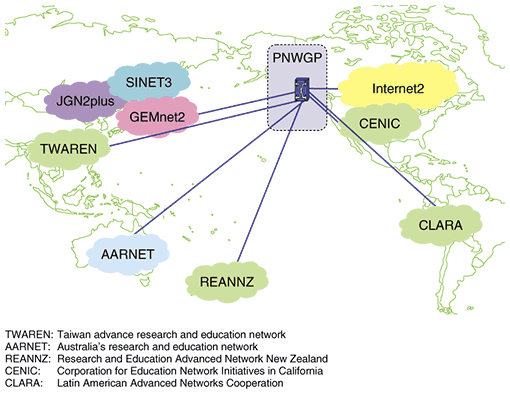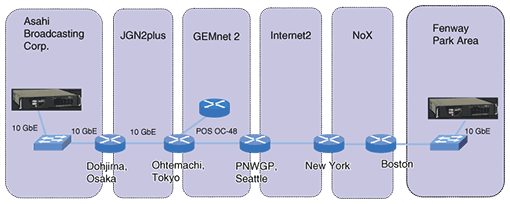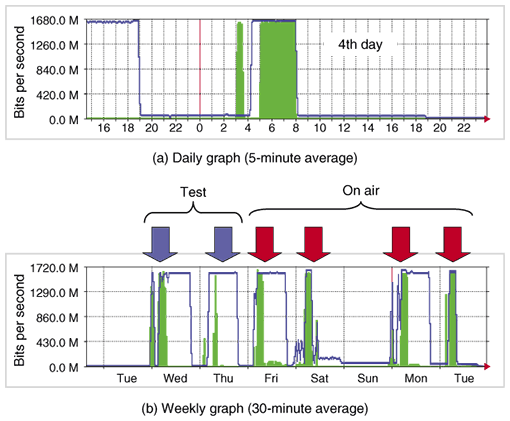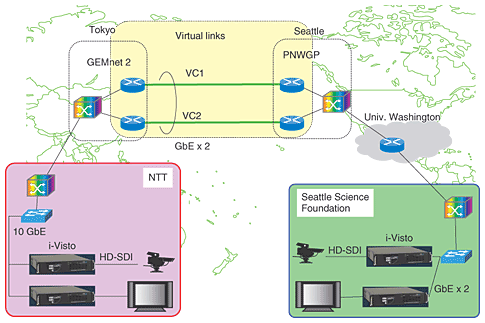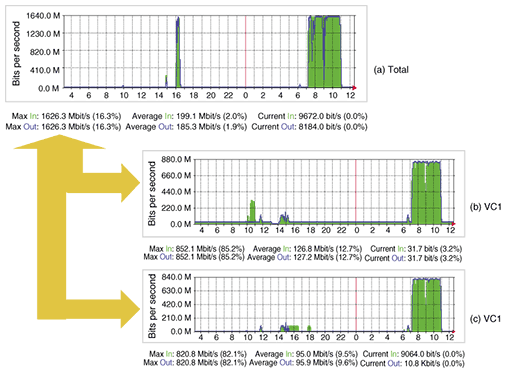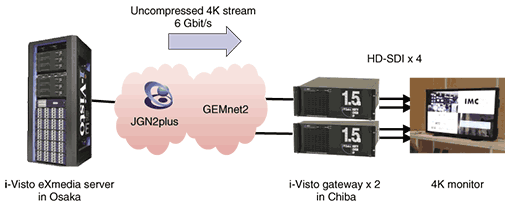 |
|||||||||||||||||
|
|
|||||||||||||||||
|
Special Feature: GEMnet2 Vol. 7, No. 2, pp. 22–27, Feb. 2009. https://doi.org/10.53829/ntr200902sf4 Transmission of High-definition Video Stream Using GEMnet2AbstractGEMnet2 (Global Enhanced Multifunctional Network) was used for an experiment on transmitting streaming data for high-definition video images because of its large bandwidth and excellent connectivity to other networks outside Japan. This article describes three trials using the i-Visto gateway and GEMnet2 in collaboration with other research and education (R&E) networks: a live relay broadcasting trial between Osaka and Boston, teleconference trial using an IP/MPLS (Internet protocol, multiprotocol label switching) link between Tokyo and Seattle, and uncompressed 4K-image transmission between Osaka and Chiba.
1. IntroductionGEMnet2 (Global Enhanced Multifunctional Network), which uses wavelength division multiplexing (WDM) transmission technology, has a very large bandwidth and provides excellent interconnection between NTT Laboratories and other research institutes all over the world through research and education (R&E) networks [1], [2]. This large bandwidth is indispensable for high-speed applications such as the transmission of high-definition images. As high-definition television (HDTV) broadcast services become popular, HD source images are increasingly being used by broadcast corporations or video image product corporations. NTT Laboratories has developed i-Visto (Internet Video Studio System for HDTV production) to transmit and store uncompressed HD streams over IP (Internet protocol) networks. 2. International connection of GEMnet2 and uncompressed HD stream transmission technologyThe connectivity of GEMnet2 is shown in Fig. 1. GEMnet2 connects NTT’s R&D centers in Musashino, Atsugi, and Yokosuka to each other [2] and has external connectivity to SINET3 (Science Information Network) and JGN2plus (Japan Gigabit Network). The international link extends to Seattle, USA, and then interconnects via PNWGP (Pacific Northwest Gigapop) [3] to Internet2 and other R&E networks in South America, Australia, and Europe. Using this connectivity, some international experiments have been performed, such as a digital cinema trial, the ALMA (Atacama large millimeter/submillimeter array) project [4], and a remote operation trial between Japan and Chile at the NTT G-Expo [1].
An i-Visto gateway converts signals from an HD-SDI (high-definition serial digital interface) or SD-SDI (standard-definition serial digital interface) into IP packet streams. An HD-SDI signal at 1.485 Gbit/s is converted into an IP packet stream at 1.6 Gbit/s, and vice versa. The most important feature of the i-Visto gateway is that HD-SDI streams are not compressed during signal conversion. Since there is no processing time for compression, the signal delay is as short as 15 ms, or half the frame rate, which is one-tenth or one-twentieth of that of the standard MPEG-2 (Moving Picture Experts Group) or H.323 video codec. 3. HD stream transmission experiments3.1 Osaka-Boston live relay broadcast trialNTT Laboratories performed an international live relay broadcast experiment with ABC (Asahi Broadcast Corporation) in April 2007. In collaboration with other R&E networks, the University of Washington, Research Channel [5], Harvard University, JGN2 plus, PNWGP, Internet2, and NoX (Northern Crossroads) [6] were connected with GEMnet2, as shown in Fig. 2. The whole network was set to use jumbo-frame packets with a maximum transmission unit size of 9000 bytes.
One i-Visto gateway was installed at ABC in Osaka, Japan, and the other was set on top of a building near Fenway Park in Boston, USA. Between Osaka and Boston, there were 11 hops, and the total delay was 105 ms or 3.5 frames. Since the delay of the i-Visto gateway was 15 ms, the transmission delay including routing time was 90 ms. Compared with a normal satellite relay, the delay in this trial was so short that the announcers felt no incompatibility and conversed smoothly across the Pacific Ocean and the American Continent. Traffic data for the router in Tokyo during the experiment is shown in Fig. 3. The experiment ran for two days of tests and four days on air. A maximum data rate of 1.686 Gbit/s was transmitted stably and continuously for six days. The system was also used for video source transmission and editing before and after the live experiment.
3.2 Transmission experiment using Japan-US IP/MPLS linkIn April 2008, we installed a new IP/MPLS (multiprotocol label switching) link as a GEMnet2 international line between Tokyo and Seattle. The interface was changed from one OC-48 POS (packet over SONET/SDH (SONET: synchronous optical network, SDH: synchronous digital hierarchy) link to two GbE (Gigabit Ethernet) links. The two GbE links were consolidated by link aggregation technology, and a virtual capacity of 2 Gbit/s was obtained. The new link is a direct point-to-point virtual circuit provisioned over the backbone network using MPLS [7]. It is comparable to legacy ATM (asynchronous transfer mode) and private line services, but leveraging IP/MPLS technology to provide an IP/MPLS-based virtual private line provides many advantages. The IP/MPLS virtual circuit across the same network eliminates all Layer 3 routing of the traffic in the network, where all packets exchanged by edge routers/switches traverse the same path. The connection between routers/switches is logically identical to both routers being plugged into a switch on an Ethernet local area network (LAN) or directly cross-connected with optical fiber. Using this new international link and i-Visto, a live TV conference on a genetics project was held between NTT Laboratories in Tokyo and the Seattle Science Foundation (SSF) venue in Seattle in collaboration with the Research Channel and the University of Washington. The purpose of this trial was to verify the performance of the newly installed IP/MPLS-based virtual private line and link aggregation technology between Tokyo and Seattle. The network configuration of the experiment is shown in Fig. 4. At NTT Labs. in Tokyo, an HD camera and HD monitors were connected to two i-Visto gateways, and HD-SDI streams were converted to IP packet streams. The i-Visto gateways were connected to GEMnet2. Two GbE links, VC1 and VC2 (virtual circuits), were aggregated using two Layer 3 switches in Tokyo and Seattle. In Seattle, GEMnet2 was connected to SSF through PNWGP and the local network at the University of Washington. At SSF, the Research Channel also prepared two i-Visto gateways, HD cameras, and monitors.
The traffic data for the IP switch in Tokyo is shown in Fig. 5. One data stream at 1.6 Gbit/s was successfully divided into two data streams at 800 Mbit/s, and two data streams were combined into one data stream. The network was stable, and there was no degradation of video image or audio signal. Round trip times for VC1 and VC2 were 90 and 100 ms, respectively. To compensate for this time difference, the buffer size of the i-Visto gateway was set to 33 ms. The conference was successfully maintained during the whole conference time of 2 hours. Since the latency was less than 100 ms, smooth conversation was obtained, and the conference attendees enjoyed this comfortable performance.
3.3 Transmission of uncompressed 4K streamThe i-Visto gateway can be extended to handle transmission of an uncompressed 4K stream. Since a 4K video has twice the resolution of an HD image in each direction (vertical and horizontal), its data size is four times that of an HD image. The configuration for the demonstration of uncompressed 4K stream transmission in cooperation with ABC in June 2008 is shown in Fig. 6. At the ABC building in Osaka, 4K-video data was stored in an eXmedia server, which is an uncompressed video server, connected to a high-speed network. The 4K-video images were separated into four HD-SDI signals. Four i-Visto gateways converted the signals into one IP stream at 6 Gbit/s. The IP data was transmitted through JGN2plus and GEMnet2 to the venue in Chiba about 600 km away.
4. SummaryUsing GEMnet2 and i-Visto gateways, several experiments on transmitting streaming data of high-definition video images have been performed. The large bandwidth of GEMnet2 and the low latency of the i-Visto gateway provided comfortable and stable performance during a teleconference across the Pacific Ocean. References
|
|||||||||||||||||








